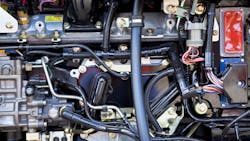Maybe it’s not so simple
It sounded so easy on paper that the U.S. could be fossil-fuel free by 2050, and Europe by 2040. But with recent developments from the European Union’s “Euro VII” proposal for new pollutant emission standards for trucks and buses, along with Wyoming—and other states—pushing back on federal mandates for electric vehicle (EV) transition, it might not end up being as simple as it sounds.
And what about diesel engine emission standards? Will diesel engine manufacturers meet the 2027 and beyond emission standards, while maintaining realistic vehicle cost and increasing fuel economy?
At the World Congress Experience in Detroit in April of last year, the Southwest Research Institute demonstrated how effective its CAT-DEF technology is. This patented and award-winning technology not only reduces heavy-duty diesel engine emissions of NOx to the levels required for 2027 but has shown it can achieve even lower emission levels. Along with the reduction in emissions is the fact that this is a backward compatible technology.
Diesel’s place in trucking’s future
In a March 30, 2022, article in Trux Magazine, written by Tom Gresham entitled “The Future of Diesel,” the author makes both a confident and bold prediction: “Still, advocates say the diesel market remains as strong and steadfast as ever, and its demonstrated capacity to adapt and evolve with changing times suggests diesel’s long-term prospects are promising.”
Continuing along in this article, the author quotes David Hughes, SVP of Pilot Flying J, as saying the diesel market is “very healthy.” Hughes comments on the resiliency, reliability, and availability of diesel fuel versus battery charging stations. With numbers higher than 50% of Class 7 and 8 diesels equipped with newer generation diesel engines, emissions are reduced along with an increase in fuel efficiency.
Open the hood on a Class 7 or 8 diesel truck and you will commonly find an inline 6-cylinder diesel engine. But is an inline 6 cylinder the best? Traditionally an inline diesel engine was the accepted norm because of to its ability to fit between the frame rails and under the hood. With new alternative engine configurations being developed, the space constraints may become a concern of the past.
As engine technology advances so does that of components. Items such as steering pressure pumps, air compressors, water pumps, and others can now be driven by electricity reducing the load on the engine. With supplemental loads removed the engine size can be reduced to focus on propulsion.
An article on LinkedIn entitled, “Automotive Camless Engine Market 2022 by Manufacturers, Regions, Type, and Application, Forecast to 2026” published June 23, 2022, said the growth of the camless engine market will increase dramatically in the U.S. between 2021 and 2030. With the decrease in mechanical components inside a typical internal combustion engine, through replacement with electronic controlled valve actuation, the result will lead to a greater power-to-weight ratio, along with lower emissions controlled through electronics, as well as higher fuel economy all in a smaller size.
I believe there are some positive outlooks for diesel based on the EPA’s Final Standards for Heavy-Duty Vehicles. The new standards beginning in 2027 will be 80% stronger than those enacted in 2007. “EPA is taking significant action to protect public health, especially the health of 72 million people living near truck freight routes in America, including our most vulnerable populations in historically overburdened communities,” said EPA Administrator Michael S. Regan.
In addition to reducing emissions from exhaust, we will see useful vehicle life increasing 1.5 to 2.5 times and emission warranties will be 2.8 to 4.5 times longer than before.
All these factors give me confidence that the internal combustion diesel engine will continue to provide years of clean service.
About the Author
Ed Chipalowsky
vehicle service and support manager, North American Council for Freight Efficiency
Ed Chipalowsky is vehicle service and support manager for the North American Council for Freight Efficiency (NACFE). In this role he will be reaching out to OEMs, fleets, vendors, and municipalities to learn about their challenges in not only developing curriculum for EV technicians but also how to recruit and develop future EV techs. Chipalowsky has an extensive background in trucking and education. He has more than 40 years’ experience as a technician manager and trainer including serving as a diesel technology instructor in both college and career and technical education high schools.
